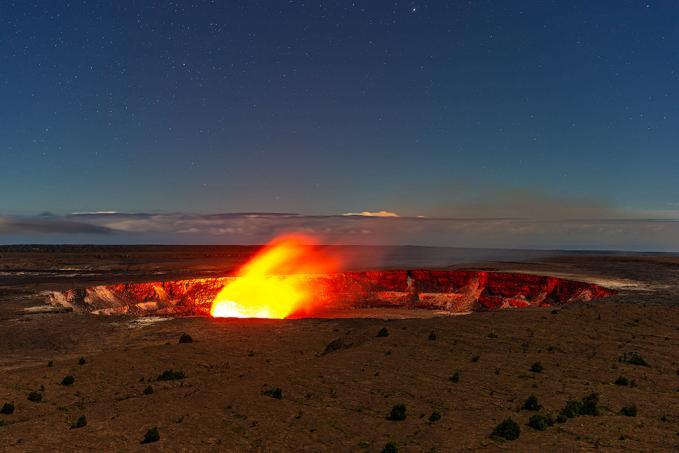Hawai’i Volcanoes National Park: Getting There
- By Rebecca Latson - September 13th, 2024 9:11am

Kīlauea volcano glowing brightly beneath the morning stars, Hawai’i Volcanoes National Park/ Rebecca Latson
Contributing photographer and writer for the National Parks Traveler since 2012, Rebecca Latson has ventured out to units of the U.S. National Park System, as well as national parks within Canada, on behalf of the Traveler. With her writing and photography, Rebecca authors the Traveler's monthly Photography In The National Parks column as well as various other national park-related articles (hiking, itineraries, photography guides, quizzes) for the Traveler.
Picture a tropical paradise where you can exhale all your stresses and worries and breathe in the salty ocean air fragrant with blooming flowers. Now, picture a high-elevation national park within that tropical paradise – a park that is constantly changing its looks by way of the active geologic processes just beneath its basalt-rock surface. This is what you’ll get with a visit to Hawai’i Volcanoes National Park on Hawai’i’s Big Island.
Where else in the United States can you witness more than one active volcano, explore a lava tube, hike through a rainforest and over a now-solid lava lake, drive over a landscape of cooled golden pahoehoe lava, walk upon a black sand beach to view endangered sea turtles, hike to a site with over 23,000 petroglyphs, take a helicopter ride over an actively erupting hot spot, or watch a hula demonstration?
Where else can you sit in any of the rooms (including the dining room and sun room) of an in-park lodge facing Kīlauea volcano to watch it steam during the day and glow fully at night through tall, wide windows?
Where else can you listen to the morning chorus of colorful, unique, Hawaiian forest birds like the ‘apapane or the ʻiʻiwi, feast your eyes on the bright red, feathery blossoms of the ʻōhiʻa lehua tree, and sample the tart sweetness of the ʻōhelo berry sacred to the goddess Pele (In Native Hawaiian custom, it is proper to offer ʻōhelo berries to Pele before consuming any oneself).
A cornerstone of Hawaiian culture and stories, this national park is home to a sacred landscape – one created by the fires of Pele.
Planning a trip to Hawai'i? Why not take a day or two to explore the wonders of Hawai’i Volcanoes. There is plenty to do and see, so don’t forget your camera.
The articles below will help you plan your Hawaiian adventure.
Traveler's Choice For: geology, volcanoes, hiking, photography
Traveler's Note: For 2024, expect closures and delays at the summit of Kīlauea due to a two-year construction project to repair or remove damaged buildings and infrastructure. To read more about the projects and construction schedule, click here.


National Parks Traveler is a 501(c) (3) nonprofit.


Here’s the definitive guide to National Park System campgrounds where RVers can park their rigs.
Our app is packed with RVing- specific details on more than 250 campgrounds in more than 70 national parks.
You’ll also find stories about RVing in the parks, tips helpful if you’ve just recently become an RVer, and useful planning suggestions.
